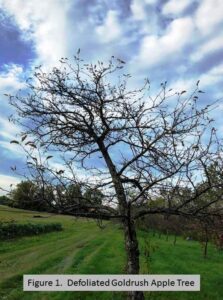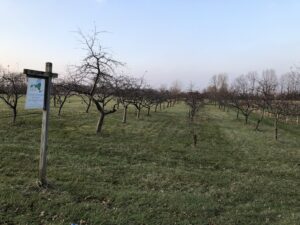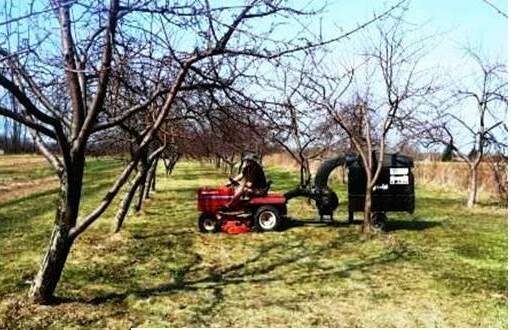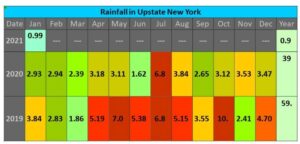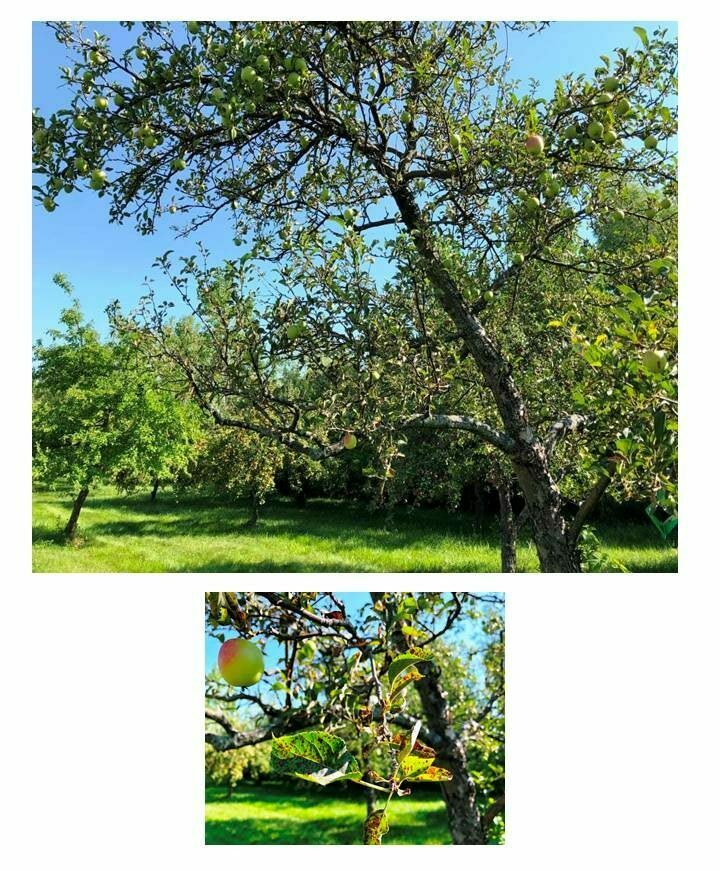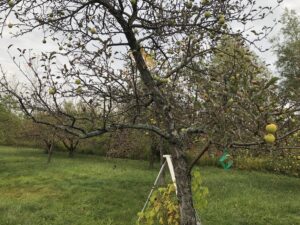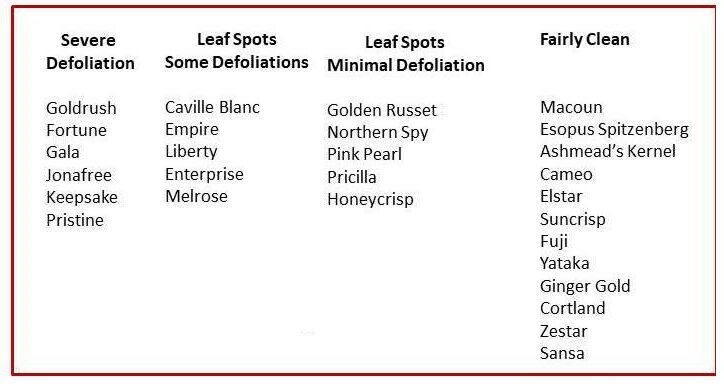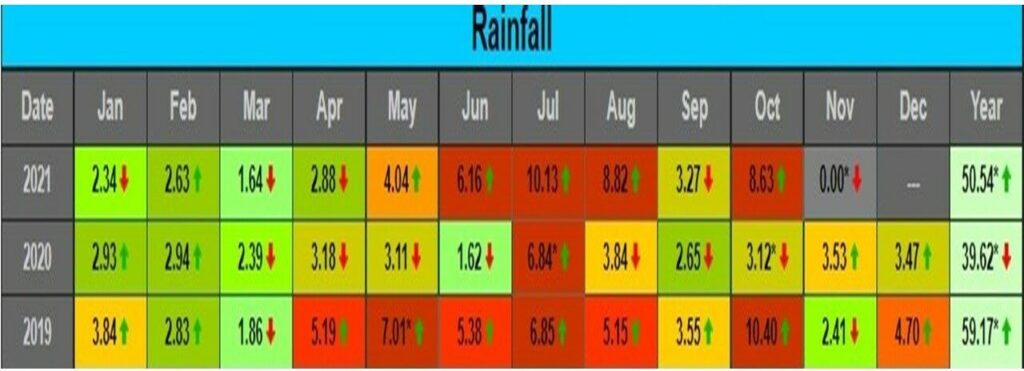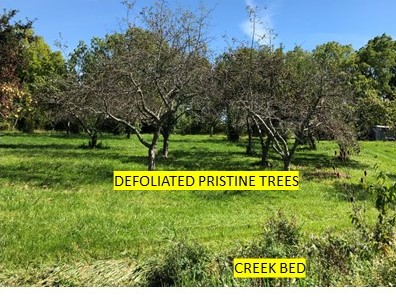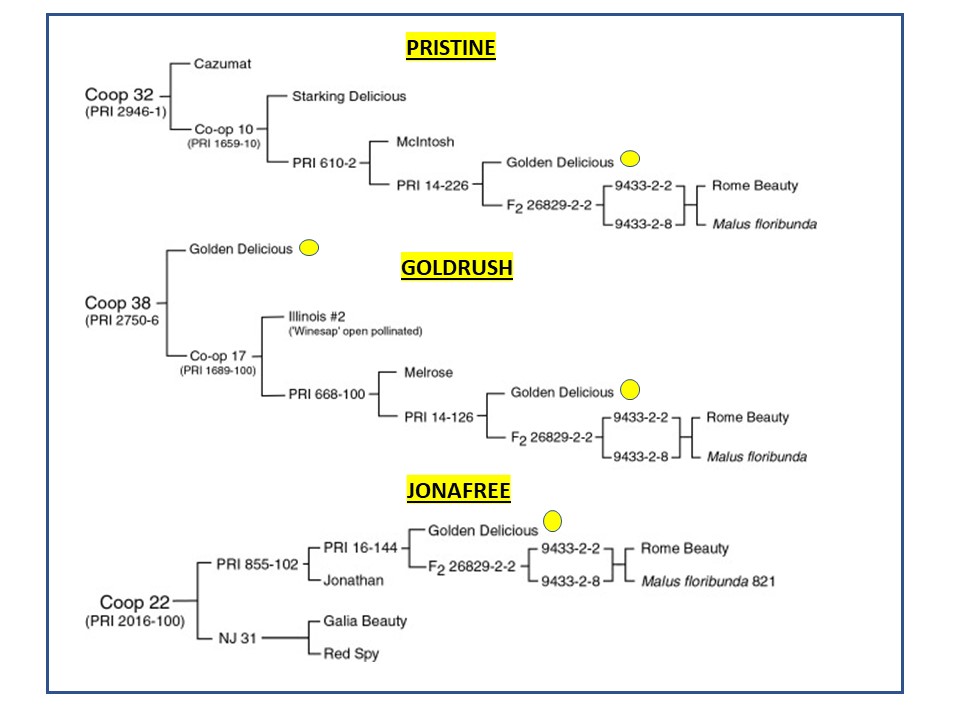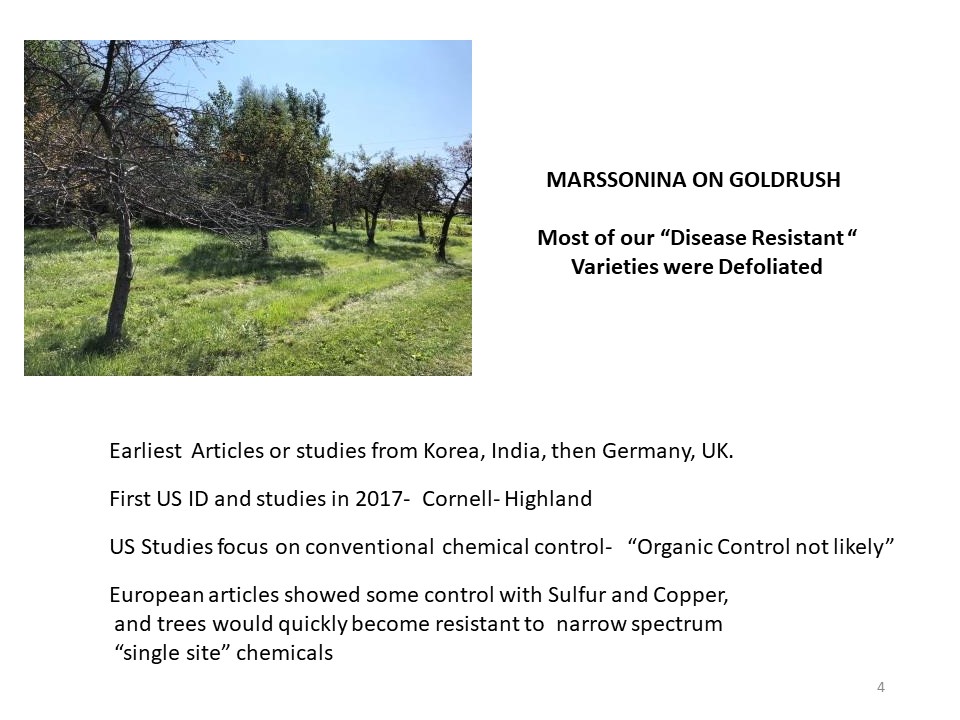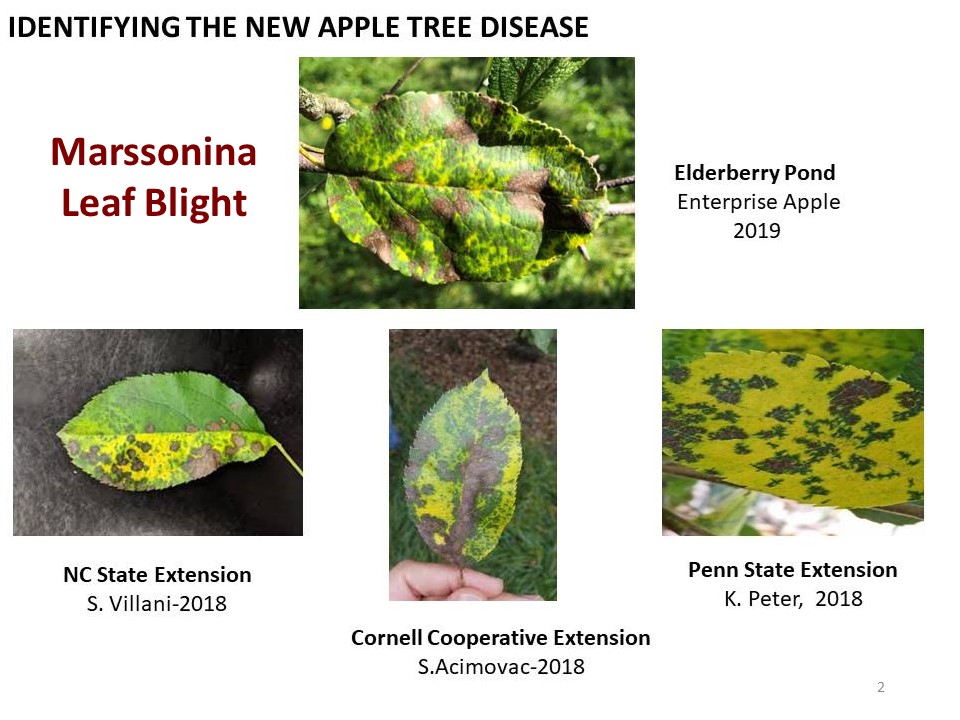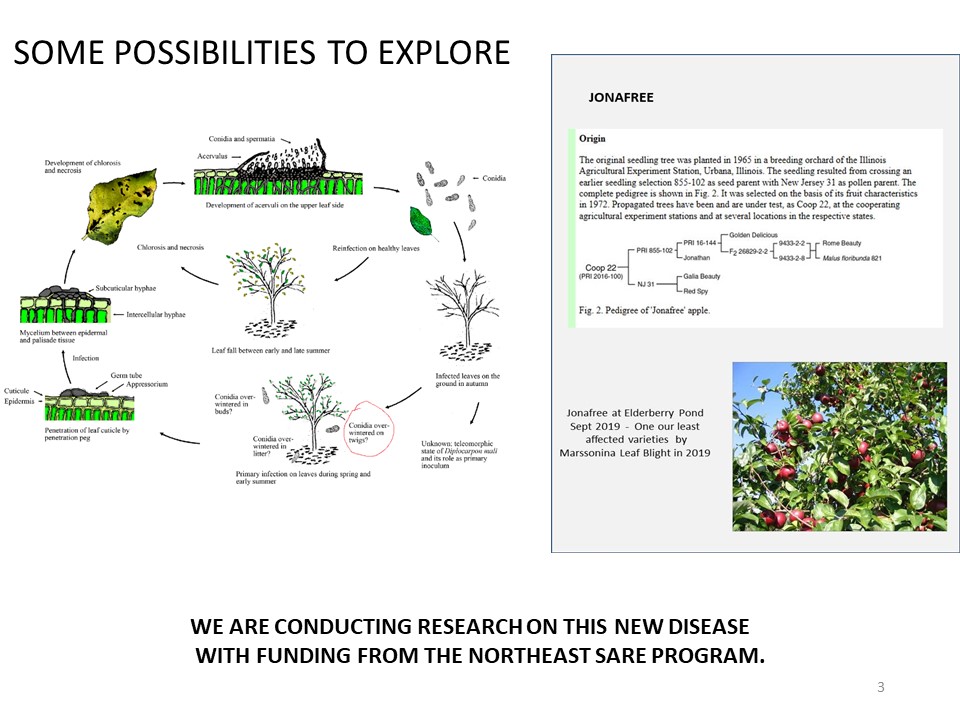Final report for FNE20-957
Project Information
Summary
Elderberry Pond is a certified organic farm in the NY Finger Lakes. We farm 35 acres of fruits, vegetables and pastured animals. Our most important crop is apples. We have about 500 trees including about 50 varieties of heirlooms, American classics, and new disease resistant cultivars. In midsummer 2019 we noticed that many of our trees were losing leaves and by September some were completely defoliated including our most disease resistant varieties such as Goldrush. (Figure 1)
We began getting calls from home orchardists that their trees had lost all of their leaves. We had NO idea of what was happening. We did a thorough online search and discovered that there was a new, very devastating apple disease called Marssonina Leaf Blight- MLB. Previous research indicated that the only the most modern chemicals offered any protection and that organic orchards would be decimated. Our objective was to determine the susceptibility of about 20 of our most popular varieties and if there were any organically approved cultural or chemical approaches to controlling this disease. Over a two-year period, we used three separate orchards to compare both chemical and cultural orchard management practices to determine what degree of control of MLB could be achieved.
We found that effective control of the disease could be obtained through extreme orchard floor clean up and tree trunk sanitization. The degree of control achieved was nearly complete in our orchard located furthest from heavily wooded areas or stream beds where clean-up was difficult.
Along the way, we have shared our findings with our Penn State and Cornell advisors, at organic farm meetings at Cornell and with e-mails and telephone calls with those that had contacted us about the problem, and also on summer tours of the farm over the two-year period.
Projective Objectives
The objective of this project was to guide organic and sustainable apple growers who have seen or are about to see the devastating effects of Marssonina Leaf Blotch in their orchards. We will describe early warning signs and timing (with leaf photographs and diagnostic test reports) leading up to tree defoliation. We will also report on some of the 50 varieties of apples we grow here in upstate New York we which have found to be the most vulnerable and most resistant to the blight in 2019, 2020, and 2021. Tests conducted in our three separate organic orchards containing some of the same varieties will show which chemical and cultural preventive measures we have found to be the most effective in combating the disease outbreak. We will compare the treatments to those we and others have successfully developed and routinely use for apple scab, a similar weather related fungal disease that threatens sustainably managed orchards. With the likelihood of more weather related diseases ahead I believe farmers, as first at the scene, have an obligation to carry out and report on early on farm based research.
Introduction
In June of 2019 we noticed that some of our apple trees were losing many of their leaves. By mid-August some of the trees were bare. We had no idea why and were most surprised by the fact that the disease resistant varieties such as Gold Rush and Pristine were the most affected. As the season progressed the situation worsened and many, but not all, of the 50 apple varieties had lost many of their leaves. We also got many calls from local gardeners and home orchardists asking why their apple trees were all defoliating. Some articles suggested the problem was apple scab. We doubted that this disease outbreak was apple scab. On a previous grant that we performed in 2012 (SARE grant FNE 11-722) Growing Scab Free Apples Without Fungicides, we studied this long existing orchard disease in detail and had virtually eliminated scab in our orchards through extreme orchard sanitization and a minimum sulfur spray program. Also, and more importantly, the defoliation was the worst on disease resistant cultivars that had been scab free for the past 15 years. Further online searches revealed that in the last year or so a new apple disease, Marssonina Leaf Blotch, MLB Marssonina coronaria. had been discovered in the Hudson Valley in September of 2017 (reference 1) and in Pennsylvania (reference 2), authored by our technical advisor, Dr. Kari Peter. The description and photographs in these Cornell, and Penn State Extension articles and other reviews exactly matched the symptoms we had observed. Nearly all the other articles we found in our online search were from Korea, Japan, India and Europe where the disease has advanced rapidly devastating their small commercial orchards. Many of these small commercial orchards, like ours, rely on simple broad-spectrum fungicides such as lime, copper and sulfur for disease control which did not appear to work. One reviewed article from Germany (reference 3), however, suggested that these chemicals might provide moderate control when applied early enough. We could find no US tests of the efficacy of these organically approved products!
It is generally agreed that the disease is propagated and progresses in much the same way as apple scab. Spores overwinter as the fungus Diplocarpon mali in leaf litter but perhaps unlike apple scab also on twigs and buds in the trees. In the spring ascospores are released which jump to newly forming buds and leaves causing a primary infection. These infections then produce secondary spores which further spread the disease. It appears that the disease shows symptoms and progresses much faster that apple scab, defoliating trees in early summer. The disease does not always scar the fruit, at least in early years. The early tree defoliation however causes fruit quality to decrease AND more importantly weakens the tree in preparation for dormancy. Some articles suggest that the only cure is removal of the trees.
Marssonina may be the most serious threat to organic and IPM apple growers in 20 years. Apple scab causes blemishes on the fruit but does not kill the tree. Field tests need to be done to discover what cultural or low impact chemical treatments organic growers can use to combat this new devastating disease. If low impact chemicals and or new cultural practices cannot not be found to prevent Marssonina Leaf Blotch and the resulting defoliation quickly, it would be a serious blow to growing organic apples in the Northeast. Getting an early start on this effort has been the purpose of this project.
The approach we took on this project is similar to that we used on a previous apple scab grant. We used our three isolated orchards containing identical verities to test and compare the effectiveness of practices and treatments on specific varieties.
Using the three separate orchards, one as a control planting, we determined the effectiveness of the following practices
Orchard 1- Further eliminating leaf and litter infection sources through improvements in our High Efficiency Orchard Vacuum built on the scab grant and some additional ground sanitization techniques.
Orchard 2- Altering spray plan to include an early season tree sanitization targeting overwintering MLB ascosporic inoculum. To guide spray timing data on leaf wetness duration, we used our existing weather sensors and data loggers and a new leaf wetness sensor to time sprays. Orchard floor leaf pickup and sanitization were as in orchard one.
Orchard 3. Control Orchard - No changes to sanitization or spray materials or practices from 2019 apple scab reduction program
Cooperators
Research
Materials and Methods
As mentioned previously we have three separate orchards with some of the same varieties of trees in each. To try to determine what changes need to be made to our orchard management to decrease MLB we will test two changes in two of the orchards and in the third we will use the same practices we used in 2019 when the serious MLB infection occurred. The three orchards can be seen in the farm orchard plan drawing (figure 2).
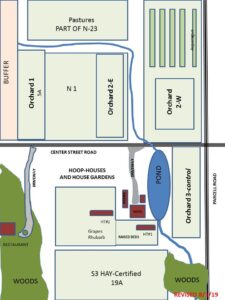
Orchard 1- Specific Tasks
Orchard 1 (figure 3) had moderate MLB, and very little Apple Scab in 2019. The focus on further reducing scab and MLB in this orchard will be on orchard and tree sanitization. Early in spring while the trees are dormant, we will work on the vacuum system. While it has worked well for apple scab there are still visible small dust particles escaping the leaf collection container that may include MLB spores. We will replace the current leaf container box (figure 4) with 3 new fully contained bags that let air escape but filter out more of the dust.
Figure 3 Orchard 1 in Early Winter
Figure 4- Leaf Vaccuum on Lawn Tractor
We will then mow and vacuum the orchard floor thoroughly and treat areas under the trees with either lime or burn them with a flame weeder. In addition, Images from the European Journal of Plant Pathology (figure 5) suggest that the MLB spores may overwinter in small cracks or crevices in the trees. In this orchard we will spray the bare, dormant trees with an OMRI approved sanitizer such as oxidate (hydrogen peroxide) which should penetrate cracks better than sulfur.
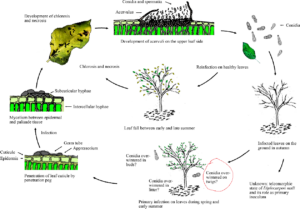
We will also purchase an Omega leaf wetness sensor which we can use with our current Omega data logging system to predict possible infections and spray sulfur only as needed for apple scab in a minimal spray program.
It is our hope that these changes to our sanitization program will help solve the MLB problem and avoid the need for increasing the amount or type of spray that we need in the orchards. This would also be the preferred system to pass to other organic growers and home gardeners who are calling us for solutions to this new problem.
Orchard #2 Specific Tasks
In this orchard we will evaluate whether a spray system more intensive than our minimum spray program used in orchard 1 is of benefit in controlling MLB. This orchard is divided in two by a stream. In both sections we will use the same enhanced ground sanitization as in orchard 1. The difference in this orchard will be a more intensive spray program with sprays based on timing rather than on modeled disease predictions. The timing between sprays will be approximately every 10 to 12 days, as many of the chemical spray manufactures recommend. Also, in this orchard we will compare sulfur (Microthiol Disperss) on one side of the creek (Orchard 2E) to an OMRI approved copper-based spray (Cueva) on the other side of the creek (Orchard 2W). Each side has some of the same apple varieties including disease resistant and conventional varieties. If we find a significant difference in the defoliation caused by MLB in these two orchard sections, we can assume that the difference is the result of the difference in spray materials. If both sections are less impacted by MLB than in orchard 1, the implication is that a more intensive spray program than our minimal program along with our enhanced vacuum cleaning and dormant tree sanitization is now required. This would not be good news since treating MLB would take us back to the aggressive spray program that was required before we devised the vacuum sanitization system. This would be particularly problematic for home orchardists.
Orchard 3 Specific Tasks
In this orchard we will use the same orchard floor treatments and minimal spray program used in 2019. This “control” orchard will be a reference to compare the impact of the other spray and sanitation techniques we try. No costs will be charged to the grant for the normal maintenance of this orchard. Only recording and documenting the results for comparison to the test orchards will be charged.
As part of this project, we will go through all of the recorded images of varieties most affected, and least affected by MLB in 2019 and their pedigree plots to see if there is any possible correlation between the pedigree and vulnerability of the variety to MLB. (Figure 6). This was highly recommended by our Technical Advisor, Kari Peter from Penn State who thought it would be valuable to other growers and researchers. Also, as figure 8 suggests, the waxiness of the leaf of certain varieties may be related to that varieties MLB susceptibility, with waxy leaves being less susceptible either by blocking spores, or we believe, by possibly reducing leaf wetness duration. We will see if in our proposed orchard trials these correlations can be observed.
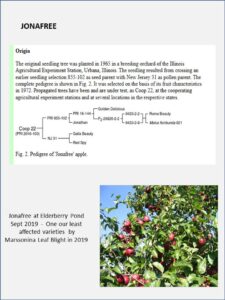
We will work closely with our technical advisors from Penn State and Cornell to interpret the observations we make in the orchards and the significance of our observations.
Degree of Damage
We will compare the MLB damage between the same varieties in each orchard. While it is difficult to measure the degree of damage we will use a simple scale of 4 degrees of damage shown below
1. Leaves Fairly Clean of spots
2. Leaf Spots- Minimal Defoliation
3. Leaf Spots with some areas of leaf defoliation
4. Sever Defoliation of Tree
2020 Research results and discussion:
We began the year pretty much as planned. In late spring after some early tasks in each orchard had been completed it became evident that the 2020 season in our area had been and would probably continue to be too dry (fig.7) to cause a serious Marssonina Leaf Blight (MLB) infection. This would in turn make it difficult to continue our research on finding organic remedies to this disease in our orchards.
Fig 7- Rainfall in Inches per Month 2019 vs 2020
In mid-August we contacted the NE SARE program office to request a 1 year no additional cost extension to our program. The following discusses results of the work completed prior to the extension which in one instance proved to be very important to the project and to the planned work for 2021.
In orchard 1 we attempted a first quick leaf cleanup using the high vacuum “fast vac” system on our Ferris mower (figure 8) but the grass and leaves were too wet. A late fall or early winter mowing would have helped the process by reducing the cut grass volume before much of the leaves had fallen. We did do such a fall mowing at the end of 2020 in preparation for 2021 spring cleanup.
Figure 8- Ferris Mower with "Fast Vac Vacuum"
On 4/15/20 we sprayed all dormant tree trunks and branches in orchard 1 with Oxidate 2.0 as planned, to eliminate overwintering MLB. The spray that fell to the ground surrounding the tree may have helped sanitize any leaf litter still present. We also flamed the grass under the trees to further eliminate MLB infested leaf particles. We again went over the orchard more thoroughly with the vacuum system on 5/3. On 5/14 we sprayed all the trees with Microthiol Disperss and Nu film P spreader/sticker. The trees were at full green tip and close to early bloom. During the remainder of the season no further fungicide sprays were applied to this orchard, and there were very few indications of either apple scab or Marssonina in any of the 20+ varieties in this orchard. This was in part due to the lack of rainfall during infection periods as discussed previously only 7.9″ vs. 18.4″ the previous year (fig 7).
In Orchards 2E and 2W we vacuumed the orchard floors thoroughly and as in Orchard 1 and sprayed tree trunks and lower limbs with Oxidate 2.0. We also sprayed orchard 2e with sulfur and 2w with copper as planned. IN ORCHARD 2W THERE WAS ONE ADDITIONAL TEST DONE WHICH TURNED OUT TO BE VERY IMPORTANT. In this orchard we selected a few varieties of trees which had two trees in close proximity that were seriously defoliated in 2019 by MLB. The varieties we chose were Goldrush, Pristine and Keepsake. In 2020 we had very little MLB in any of the orchards including Orchard 2 which had those varieties that we paired for testing, with one important exception, Goldrush. In August, the tree that had not received the Oxidate bark and limb spray began to show signs of MLB (Figure 9), and by November was totally defoliated (figure 10).
Figure 9. Tree not receiving Oxidate Trunk Spray shows signs of MLB
Figure 10- Goldrush Tree totally defoliated in November
The tree that had received the Oxidate Bark Spray remained free of Marssonina Blight throughout the season and produced near perfect fruit (figure 11) below.
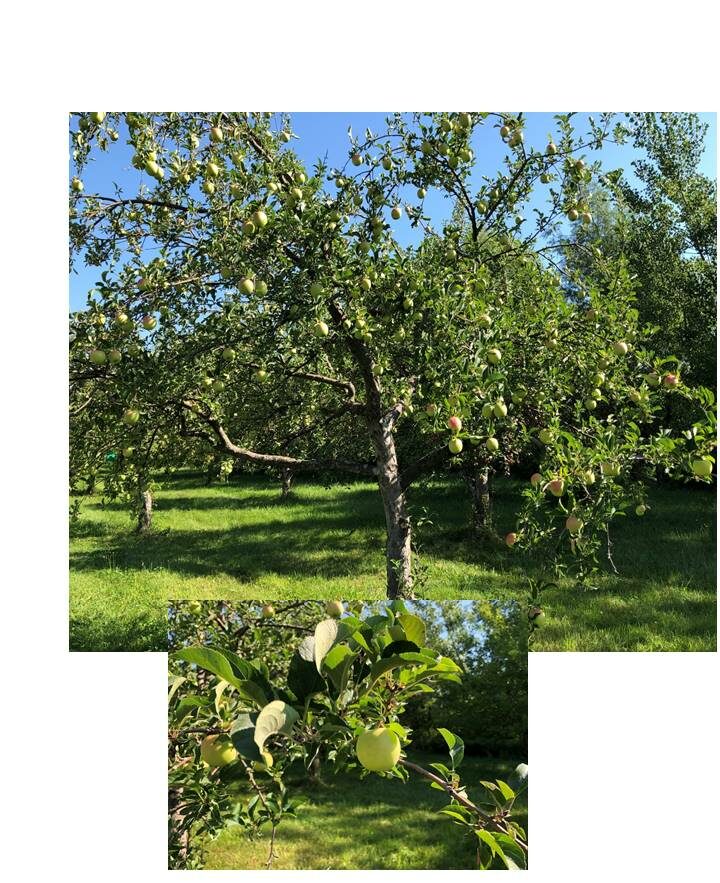 Figure 11. Goldrush Tree receiving trunk spray had little or no MLB Blight
Figure 11. Goldrush Tree receiving trunk spray had little or no MLB Blight
While this is only one test on one variety in one season, I believed it was dramatic enough that more of these comparative tests must be included in in the second year, 2021 MLB project. We have also reported the tests on Goldrush to several other northeast organic apple growers as well as our technical advisors hoping that they would perform one or more of these two tree comparative tests in their own orchards in 2021.
In Orchard Three we managed the trees as we had done in previous years with through cleanup of fallen leaves and a mid-May green tip spray of sulfur. No bark or lower limb sprays of Oxidate were performed in this orchard. Throughout the dry 2020 summer the trees remained nearly free of apple scab and MLB.
With the exception of Goldrush the varieties listed below (figure 12) present in one or more of the orchards and had various degrees of MLB infections in 2019 had minimal leaf or fruit disease in 2020.
Figure 12. Degree of MLB Leaf Defoliation in 2019
2021 Research Results and Discussion
As mentioned previously we decided to continue the investigation of MLB during the 2021 season hoping it would be a more representative (wetter) growing season. As it turned out it was one of the 4 wettest years on record in upstate NY and did provide some interesting and useful new information on the disease.
Spring 2021 Weather
Figure 13-Rainfall through October 2 Higher Than Normal Annual Average
The unusually high rainfall in 2021 (figure 13) provided more information on the susceptibility of our many apple varieties to Marssonina. It also provided new insight on the impact of overwintering infection sources such as leaves in causing spore infections. In the following paragraphs we will describe the preparations we took in each of the orchards and the effectiveness of these preparations in presenting disease during this year of record rainfall.
2021 Spring Orchard Preparations
In early April we vacuumed all of our orchards as we had done in previous years. On 5/18 we sprayed all the trees with either Microthiol Disperss Sulfur or Copper and Nu film P spreader/sticker just as we had done in 2020. Tree trunks of the trees were also sprayed with Oxidate 2.0. The trees were at full green tip and close to early bloom. We also marked 5 varieties of apple trees in orchards 1 and 2 where we had two trees of the same variety in close proximity with tape indicating that one of the trees were trunk sprayed and one received no trunk spray. This would expand the test we did in 2019 and 2020 with Goldrush to more varieties we believed were susceptible to Marssonina.
In June, July and August we had much more rainfall than we had had in either of the previous two years (figure 13) and began to see Marssonina on many varieties in orchards 2 and 3. In these orchards many trees were nearly totally defoliated. In spite of the greater level of disease in the orchards, the relative susceptibility of different apple varieties was similar to that in 2019 (figure 12) with Goldrush, Jonafree and Pristine showing the earliest and most severe defoliation. In orchard 1, there was far less MLB and relatively little damage. The reason is (we believe) that this orchard is more isolated from overwintering leaves in woodland and creek beds where it is much more difficult to pick up fallen leaves than it is in orchards 2 and 3 where enjoining creek beds such as the one shown below (figure 14) make it difficult to collect fallen leaves.
Figure 14 - Orchard 3 - Creek Bed Enjoining Orchard Floor
The decision to continue the research on Marssonia Leaf Blotch into a second year turned out to be very useful, since the results now contain observations from one of the driest years (2020) and wettest years (2021) in recent history in Upstate New York. The comparative results of these two years are summarized below.
1. In both 2020 and 2021 our extreme leaf pick-up and orchard floor cleaning to prevent apple scab was done in all three orchards, and little or no scab was present at harvest.
2. In both 2020 and 2021 the same varieties (figure 12) showed similar signs and degrees of leaf damage and defoliation from Marssonina, but the damage in all varieties was much more severe in all these varieties in the wetter year (2021)
3. In both years the degree of leaf spotting and defoliation on the same varieties was lower in varieties receiving the oxidate bark spray, but the difference was more dramatic in the drier year (2020).
4. In both years there was more MLB damage in orchards 2 and 3 bordering the stream where leaf pick up was difficult than in orchard 1 which does not border a stream.
The conclusions we have reached as a result three-year observation and evaluation of MLB on our farm are:
- That complete leaf clean-up from the orchard floor in the spring and fall combined with a spring spray of an oxidizing agent such as oxidate on the trunk and lower branches can nearly eliminate MLB in both very wet and very dry years in an orchard isolated from creaks or woodland where complete leaf is not possible
- That "complete clean-up" includes all surrounding ground within approximately 50 yards of the trees. This clean-up area was larger than we expected in our very wet year (2021)! In many situations, including three of our four orchards, the clean-up area may include areas such as stream beds which are nearly impossible to clean up.
- That there is a great difference in the level of apple variety susceptibility to MLB among the 24 varieties we tested with some of the otherwise disease resistant varieties such as Jonafree, Goldrush and Pristine, found to be the most susceptible to this particular disease, and other varieties such as Ginger Gold and Macoun more resistant. (Figure 12).
- The only common link we could find in the pedigree maps (figure 15) of these otherwise disease resistant varieties was the presence of Golden Delicious in both Goldrush and Pristine and Jonafree. Although we have no Golden Delicious, it is reported to be very susceptible to MLB. We are not sure what, if any, role pedigree plays in susceptibility, but in our small sample there appears to be a connection.
Figure 15- Pedigree of three highly susceptible varieties to MLB
References:
- "Marssonina Leaf Blotch of Apple" - Tree Fruit News Vol6 Issue 7 October 2019- Cornell Cooperative Extension Eastern Commercial Horticulture Program
- "Apple Disease-Marssonina Blotch" - Penn State Extension News, September, 2017
- " Symptom Occurrence and Disease Management of Marssonina Blotch" A. Bohr KOB D88213 Ravensberg, Germany
Education & Outreach Activities and Participation Summary
We also presented a poster session talk at Cornell in early 2020 that included a discussion of MLB and our research on causes and cures.
In 2020 we sent a summary research report to 4 Organic Apple Growers in the area suggesting that they try some of the MLB treatments that we tried as part of our SARE Grant on their apple plantings during 2021.
Participation Summary:
In January 2020 we presented an overview of Marssonina Leaf Blight at the NOFA Conference. We described the problem and our approach to discovering organic solutions. We heard from many farmers who had seen the destruction to their apple trees by MLB and were interested in getting updates as our research continued. Some of the slide presented at this meeting are shown below
In December 2020, we sent out letters to several organic apple growers and to some educators which were either advisors on this grant or people we discussed the grant with which contained the information described in the previous section on the apparent success we had with Oxidate trunk and limb treatments in reducing Marssonina Leaf Blight on Goldrush apple trees. We requested that, if possible, they try some of our techniques at their sites. Due to the extension of the grant into 2021 , and the lack of many conferences this year due to COVID, any additional outreach presentations or articles/press releases were delayed.
Learning Outcomes
No feedback to date, although all of our annual get togethers have been cancelled due to COVID.
Project Outcomes
Our first observance of total apple tree leaf defoliation of many of our favorite varieties in 2019 was frightening. Particularly alarming was that the most affected varieties were our disease resistant varieties that had done so well without disease sprays for years. We asked other orchardists in the area and some organic apple growers, and only the organic growers reported seeing similar tree leaf loss in midsummer. After identifying the disease as Marssonina Leaf Blight (MLB), we selected about 20 varieties (figure1) to use in the assessment of different treatments effectiveness in controlling the disease.
Figure 1- Varieties selected for MLB Testing
A few years earlier we had discovered that very intense orchard floor cleanup fall and spring using a lawn tractor "Fast Vac"leaf vacuum provided almost complete control of apple scab, by eliminating overwintering spores on fallen leaves. In 2019 we found that the orchards where leaf pickup was the most complete MLB was minimal, though not totally controlled.
In 2020 we tried included applying the organically approved fungicides including Cueva (Copper) and Micro Thiol Disperss (Sulfur). These tests indicated that neither Copper or Sulfur had much effect in preventing or curing MLB.
Another test we tried in 2020 was to spray the trunks and lower branches of one of two closely spaced trees of the same variety with oxidate (hydrogen peroxide). The results of this test were extraordinary, particularly on the most susceptible variety (Goldrush). The trunk spray, in combination with a very through orchard floor cleanup seemed to eliminate the occurrence of MLB on the most susceptible varieties.
In 2021, a much wetter summer (Figure 2.) we repeated the test. Although there was more leaf defoliation on the susceptible
Figure 2 Rainfall Comparison
varieties, the trees with the oxidate trunk spray had much less MLB. We now believe that thorough orchard floor cleanup fall and spring along with a sanitization of tree trunks and lower branches can practically eliminate the damage to apple trees and fruit from both apple scab and Marssonina Leaf Blight.
The results of this project conducted over a two-year period (one very dry and one very wet) have convinced us that both Apple Scab and MLB can be controlled in certified organic orchard. We will continue to use this approach in the future in all three of our apple plantings and will pass on our results to other organic orchardists at every opportunity. We are very appreciative to the northeast SARE program for providing funding to carry out this project and for the no cost project extension to test in a very wet year (2021).
